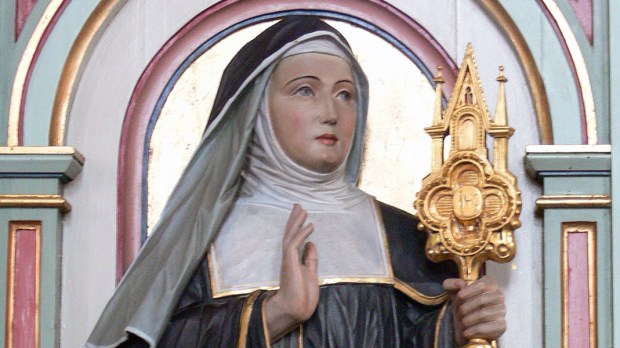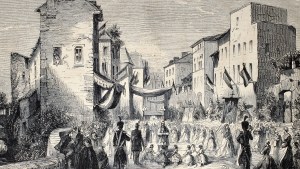
Philip Kosloski at Aleteia:
The celebration of Corpus Christi can be traced to a vision that a 13th-century Belgian nun named Juliana had of the liturgical year.
The Roman Rite of the Catholic Church celebrates the feast of Corpus Christi (Body and Blood of the Lord) each year after Trinity Sunday.
However, the Church did not always celebrate this feast, and a large influence behind it was a a 13th-century Belgian nun named Juliana.
St. Juliana’s vision
Juliana was deeply devoted to the Holy Eucharist from an early age and according to Aleteia writer Joanne McPortland, “entered religious life at the age of 13, serving in a hospice for lepers run by her community.”
It was during this time that she began to have a peculiar vision. Author Heinrich Stieglitz narrates the vision in his book The Church Year: Talks to Children:
As early as her sixteenth year Juliana had a remarkable vision while she was at prayer. She saw the full moon shining brightly, but upon it was a dark spot as if a piece of it were broken out. At first she could not understand the vision. The oftener she looked at this strange sight, the more her wonder grew.
Initially she thought the vision was demonic in origin and begged God for help:
“Is it a temptation of the Evil One?” she asked anxiously. She prayed earnestly and yet the vision remained. Amid burning tears the girl asked her loving Savior to please explain to her what it meant.
According to the account, Jesus responded to Juliana’s request and told her exactly what the vision was supposed to represent:
Finally Jesus told her, “The moon represents the ecclesiastical year. The dark spot within its shining surface means that there is still one feast missing. It is My will that a great festival be instituted in honor of My Sacred Body. Holy Thursday is more a day of sorrow than of joy. Now go and announce it to the world.” The humble nun shrank from such a task and told our Lord so, “Lord,” she said, “I am only a simple maiden and I am not at all worthy. So please entrust this work to holy and learned priests.”
Initially Juliana didn’t tell anyone, but over time she confided her vision to a few people and then the account made its way to the pope himself.
While St. Thomas Aquinas would eventually write beautiful poetic hymns for this new feast, the celebration would likely not exist if it weren’t for the holiness of St. Juliana and her openness to receive God’s word.

Read more:Juliana of Liege, the 13th-century religious woman who brought us Corpus Chris





